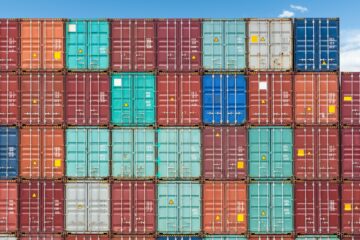
Note: Today’s post is part of our “Editor’s Pick” series where we highlight posts published by our sponsors that provide practical knowledge and advice on timely and important supply chain and logistics topics. This recent post by Veronica Turk from Loadsmart highlights a recent Talking Logistics episode with Adrian Gonzalez and George Swartz, Loadsmart’s VP of Shipper Solutions, on how managed transportation services enable resilient supply chains.
The conversation [between Adrian and George] centered around how transportation and logistics leaders shouldn’t get complacent with the status quo. Though we may be in a “shipper’s market,” that could change at any time. It’s imperative that shippers take action now before the pendulum swings again.
Below are some highlights from the conversation and key takeaways shippers looking for ways to maximize their logistics operations should consider.
Q: In your conversations with shippers who just came through Covid, what does ‘resiliency’ look like and how do you, as an industry veteran, interpret it?
A: Resiliency has a few connotations when you talk about supply chain and logistics. Two of the main things people associate with resiliency is the notion of flexibility and speed to react. Things are changing, and doing so rapidly. Even isolated supply chain events that aren’t going to result in long-term changes are important to be able to quickly react to and flex around in the short term. Shippers want to be ready for unplanned events so they can make the quick changes needed so as not to disrupt their operations as much as possible.
It’s the opposite of the old, static supply chain where nodes were set in stone and largely immovable.
The old adage “failure to prepare is preparing to fail” is especially true for supply chains right now.
Q. How is the transportation landscape changing — or need to change — in response to these challenges and risks?
A. There are several challenges impacting the transportation landscape. There’s the traditional problems like driver shortages which are being exacerbated by lack of incoming truckers. Then there are new factors: millennials and Gen Z are getting more and more involved with the gig economy. This creates a huge opportunity for last-mile deliveries, but makes it harder to cover a long-haul shipment.
We’re also seeing a lot more micro fulfillment centers being set up, which is putting goods closer to the market. Additionally, companies are increasingly thinking regionally, pushing more shipments into intermodal and rail instead of on coast-to-coast tractor-trailers. This change is in part due to the desire to reduce costs, a secondary goal is also to reduce emissions by eliminating miles.
- SEO Powered Content & PR Distribution. Get Amplified Today.
- PlatoData.Network Vertical Generative Ai. Empower Yourself. Access Here.
- PlatoAiStream. Web3 Intelligence. Knowledge Amplified. Access Here.
- PlatoESG. Carbon, CleanTech, Energy, Environment, Solar, Waste Management. Access Here.
- PlatoHealth. Biotech and Clinical Trials Intelligence. Access Here.
- Source: https://talkinglogistics.com/2024/04/10/editors-pick-how-managed-transportation-services-enable-resilient-supply-chains/
- :has
- :is
- :not
- :where
- $UP
- a
- Able
- About
- Action
- Additionally
- adrian
- advice
- again
- also
- an
- and
- any
- ARE
- around
- AS
- Associate
- At
- BE
- before
- being
- between
- but
- by
- came
- CAN
- centered
- Centers
- chain
- chains
- challenges
- change
- Changes
- changing
- closer
- Companies
- Consider
- Conversation
- conversations
- Costs
- could
- cover
- Covid
- creates
- Deliveries
- desire
- Disrupt
- do
- does
- doing
- driver
- due
- economy
- editor
- editor's pick
- eliminating
- Emissions
- enable
- episode
- especially
- Even
- events
- factors
- few
- Flexibility
- For
- from
- fulfillment
- Gen
- Gen Z
- George
- get
- getting
- gig economy
- goal
- going
- goods
- harder
- Highlight
- highlights
- How
- HTTPS
- huge
- impacting
- imperative
- important
- in
- Incoming
- increasingly
- industry
- instead
- interpret
- into
- involved
- isolated
- IT
- jpg
- just
- Key
- knowledge
- Lack
- landscape
- largely
- leaders
- like
- logistics
- long-term
- Look
- look like
- looking
- Lot
- Main
- make
- MAKES
- managed
- Market
- Maximize
- May..
- micro
- Millennials
- more
- much
- Need
- needed
- New
- nodes
- Notion
- now
- of
- Old
- on
- Operations
- Opportunity
- opposite
- or
- our
- part
- People
- pick
- plato
- Plato Data Intelligence
- PlatoData
- possible
- Post
- Posts
- Practical
- Prepare
- preparing
- problems
- provide
- published
- Pushing
- Putting
- Quick
- quickly
- Rail
- rapidly
- React
- ready
- recent
- reduce
- regionally
- resilient
- response
- result
- right
- risks
- s
- secondary
- seeing
- Series
- Services
- set
- several
- Short
- shortages
- should
- So
- Solutions
- some
- speed
- Sponsors
- static
- Status
- STONE
- supply
- supply chain
- Supply chains
- Swings
- Take
- Takeaways
- Talk
- talking
- term
- that
- The
- their
- then
- There.
- These
- they
- things
- Thinking
- this
- though?
- Through
- time
- timely
- to
- today’s
- Topics
- traditional
- transportation
- transportation services
- truckers
- true
- two
- veteran
- vp
- want
- ways
- we
- were
- What
- when
- which
- WHO
- with
- you
- Your
- zephyrnet












